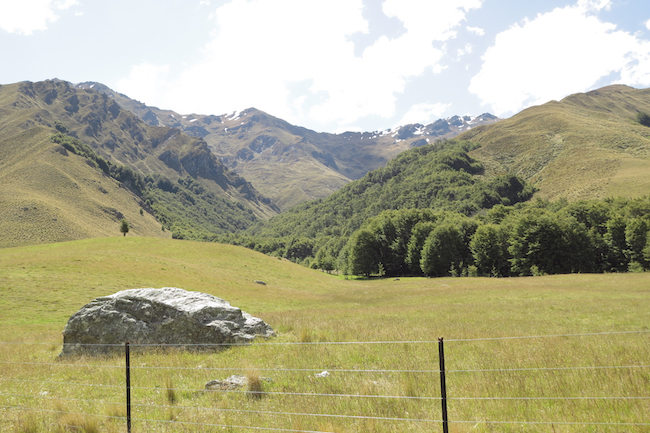Imagine if we could establish native vegetation as easily as sowing pasture – a customised seed-mix applied at the hectare scale using agricultural techniques. Imagine if together with seeds we could reintroduce the native mycorrhizal fungi upon which many of our native species depend. Such an approach would drastically reduce the cost and increase the success rate of native reforestation in New Zealand.
Establishing large-scale native forests from seeds
One Billion Trees Seeds Project Ngā Kākano Whakahau, a collaboration between the QEII National Trust, Department of Conservation and University of Otago, is developing practical methods for the large scale establishment of native forest from seeds. However, the project is as much about below-ground rehabilitation as it is about above ground revegetation and is especially focused on protocols that can be implemented by community groups. Lead by University of Otago botanist Janice Lord, the project aims to combine agricultural seed delivery methods with a detailed understanding of how to enable germinating seeds to reconnect with essential mycorrhizal fungi.
Partnerships bring innovative technology and expertise to seedling trials
Phase 1 of the project, co-funded by the Biological Heritage National Science Challenge has involved isolating and identifying mycorrhizal fungi associated with beech and Manuka on the Mahu Whenua QEII covenants between Arrowtown and Wanaka, and working on methods to extract and store viable fungal spores.
Mahu Whenua ecosantuary website
Phase 2 of the project commenced in June 2019, and has secured three years of funding from the Ministry of Primary Industries under the 1 Billion Trees Programme. It involves large scale seeding trials at field sites at Mahu Whenua and High Peak Station, Canterbury, comparing different sowing methods, approaches to site preparation and weed control, as well as fungal inoculation. We are also investigating the reproductive biology and fungal associations of key species and undertaking glasshouse trials to support work in the field.
This work is being made possible with in-kind contributions from the University of Otago, QEII Trust, Soho Properties, High Peak Station and Department of Conservation. Further expertise is being provided by Red Tree Environmental Solutions Ltd, and project manager Hilary Lennox from Ahika Consulting Ltd.
Ahika Consulting website
A number of hectares on both Motatapu Station and High Peak Station have been sown with native seed mixes using a conventional disk drill, a minimal tillage CrossSlotTM drill, and the Department of Conservation's Burford drill, now operated by SeedNZnative.
SeedNZnative website
RedTree Environmental's Enviroblanket™ technology, which involves the application of mulch over a large area into which the seeds are sown.
RedTree Environmental Solutions website
Postgraduate students investigate optimum conditions for native seedlings
A number of postgraduate projects are associated with Ngā Kākano Whakahau. Laura van Galen's PhD thesis focused on factors that affect beech seedling germination and survival rates in grasslands. One of the most important factors is the presence of ectomycorrhizal (EM) fungi, due to the obligate relationship between this type of fungi and beech trees. Other factors such as soil nutrients, grass competition and the availability of microsites also play a role and so her experiments are testing these factors in combination in a large trial covering c.1 hectare at Mahu Whenua.
Merissa Strawsine's MSc thesis examined the role of Manuka in facilitating the establishment of native beech species from seed. NZ beech species are the only native trees that form associations with EM fungi alone. However, Manuka and kanuka can host EM fungi in addition to the more generalist arbuscular mycorrhizal (AM) fungi. Merissa is examining how fungal diversity on Manuka roots is associated with beech seedling establishment.
Herbicides are a common tool in restoration and reforestation projects. Experiments at Mahu Whenua, as part of Ngaio Emson's MSc, will determine the optimal amount and type of herbicide that can reduce competition from weeds without causing significant harm to native seedlings. This information will be valuable in any restoration project because competition from weeds can be a problem when trying to establish slower-growing native species from seed.
Ngā Kākana Whakahau also connects with an increasing number of projects examining aspects of restoration, reforestation and carbon sequestration by native trees, for example, the Wakatipu Beech Seeding Project and the Coronet Peak planting project.
Completed postgraduate theses associated with this project:
- Merissa Strawsine (MSc): Can Mānuka mycorrhizal fungi facilitate southern beech establishment?
- Cara-Lisa Schloots (MSc): Water level fluctuation and vegetation patterns within an alpine wetland complex.
- Laura Van Galen (PhD): Facilitating beech forest restoration: understanding edge dynamics and drivers of distribution.
- Ngaio Emson (MSc): The effects of wilding conifer control: herbicide impacts on above and below ground communities in tussock grasslands.
Postgraduate research in progress:
- Ben Teele (PhD): Restoration of woody species in dryland ecosystems.
- Alistair Barber-Sperling (MSc): The effect of distance on the ectomycorrhizal colonisation of beech seedlings.
- Kate Moss-Mason (MSc): Improving native forest restoration practices in Aotearoa-New Zealand
Publications relating to this project:
- Flammability trajectories following destocking and forestation: a case study in the New Zealand high country
- Restoration of southern hemisphere beech (Nothofagaceae) forests: a meta-analysis
- Barriers to seedling establishment in grasslands: implications for Nothofagus forest restoration and migration.
- The effect of stratification and shade on germination of Nothofagus cliffortioides (Hook.f.) Oerst seeds.

Motatapu beech forest fragments.